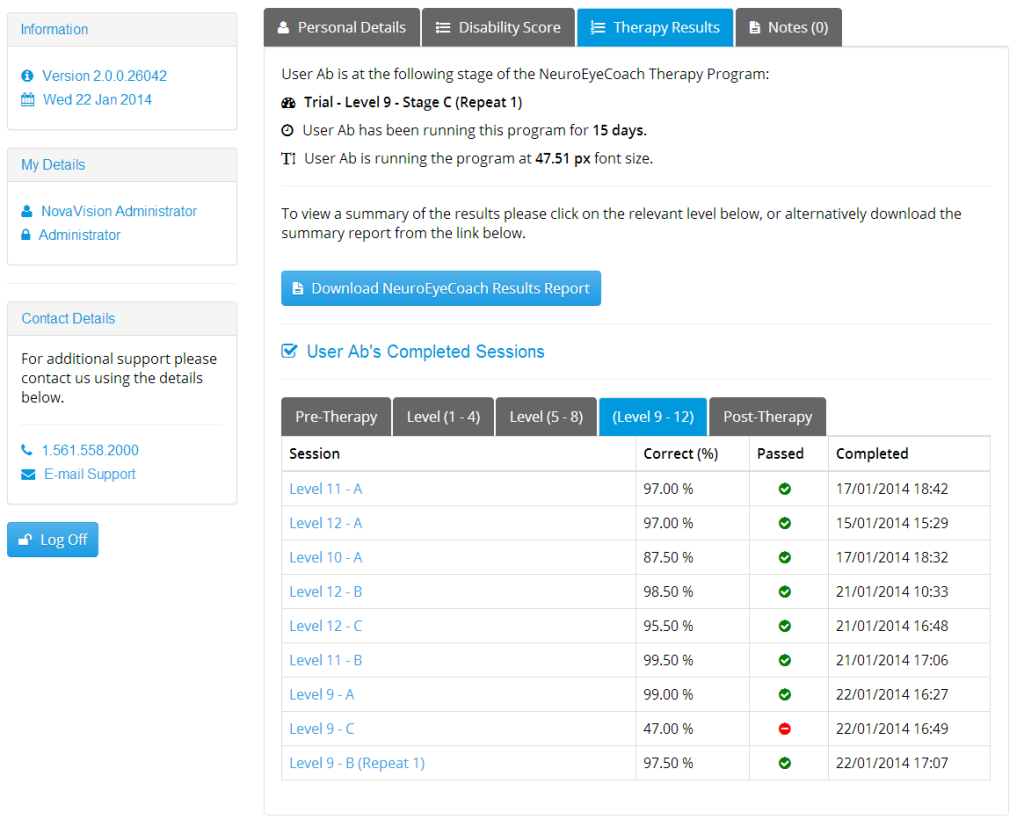NeuroEyeCoach is an innovative program that evolved from Professor Zihl’s extensive research and pioneering of a computer-based saccadic treatment approach. This has been the subject of 13 studies on a total of 551 patients with homonymous visual field loss and persistent visual disabilities resulting from neurological brain damage. It distils all of Professor Zihl’s and subsequent clinical studies findings into one comprehensive therapeutic product for improving a patient’s ability to scan their environment more efficiently.
The user-friendly application provides optimum usability because no intensive measures are required to use it or to supervise its use. The program is accessible both within rehabilitation centres and clinics and within a patient’s home.

Since patients can access this therapy directly over the Internet on their own computer the therapy is not restricted to rehabilitation centres or clinical institutions. Every patient with neurologically induced visual disorders can have easy access to the therapy and benefit from this program. The therapy is designed to improve visual search efficiency in patients, leading to greater confidence in performing activities of daily living.
Rehabilitation Of Vision Deficits After Brain Injury
Visual field deficits after stroke or brain injury can be overlooked early on as more severe, and life-threatening, injuries sustained from the stroke or brain injury are treated. Patients should undergo a vision evaluation as soon as possible after their injury. Even if a patient does not perceive any problems with his or her vision, defects may be present, and they can have an extensive impact on the patient’s life and rehabilitation efforts.
Spontaneous Improvement And Recovery
Within three months of a stroke or brain injury, it is common for patients to experience spontaneous improvement and occasionally full resolution of their visual field deficits. In other words, some vision difficulties will clear up by themselves. However, in many cases, spontaneous recovery is partial and the remaining vision difficulties require therapeutic intervention. While a spontaneous recovery may take place, less than 20% of patients develop an effective compensatory behaviour spontaneously.
Contraindications, Warnings, And Precautions
Contraindications
Patients with the following medical or physical conditions must not undergo NovaVision NeuroEyeCoach therapy:
- History of seizure disorders, especially those of a photosensitive nature. In patients with uncontrolled photosensitive seizure disorders, NovaVision NeuroEyeCoach may have adverse effects including, but not limited to, seizures.
- Severe cognitive defects, particularly due to the requirement to be able concentrate for training sessions lasting approximately 15-20 minutes, two-six times a day for a maximum of two hours and for a minimum of three times a week.
Warnings
- Patients with active acute inflammatory diseases of the eyes or central nervous system should not initiate NeuroEyeCoach until the acute phase has subsided.
- NovaVision NeuroEyeCoach will not be effective for patients without any residual vision whatsoever (i.e., total cortical blindness).
- NeuroEyeCoach requires patients to be seated for extended periods of time. If the patient has been previously diagnosed with deep vein thrombosis (DVT) or has been identified by their physician as having an increased risk of experiencing DVT, the patient should first consult with their physician before initiating NeuroEyeCoach.
Precautions
The following conditions are not treatable by NeuroEyeCoach, may impact the ability of a patient to carry out NeuroEyeCoach, and/or may reduce its effectiveness:
- Uncorrected vision defects such as myopia, hyperopia, astigmatism, presbyopia or tropia (strabismus).
- Nystagmus.
- Progressive disorders such as glaucoma, multiple sclerosis, diabetic retinopathy or macular degeneration.
- Although there are no age limits for the therapy, NeuroEyeCoach is not recommended for children, due to the requirement to be able to concentrate for training sessions lasting approximately 15-20 minutes, two-six times a day for a maximum of two hours and for a minimum of three times a week.
Risks
In common with all activities requiring extended use of a computer screen, NovaVision NeuroEyeCoach may cause light headaches or fatigue if performed too intensively or without sufficient relaxation periods (breaks). If this occurs, patients should take more frequent breaks during the session. If this persists, patients should temporarily discontinue the therapy until symptoms subside.
Next Steps:
Read Clinical Studies | Become A NovaVision Pro Physician or Center | Who Can Benefit

